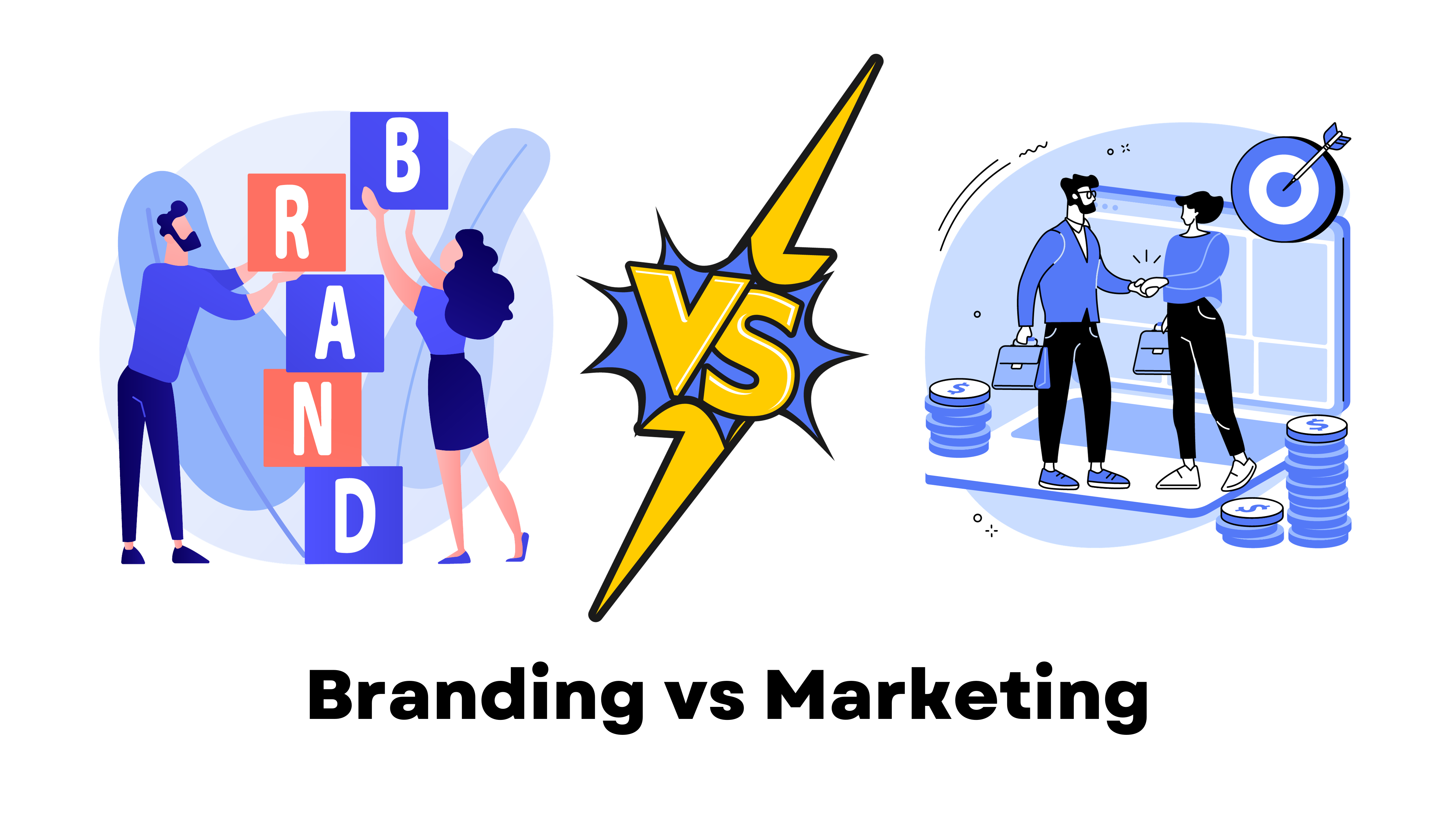Branding Vs Marketing
Branding and marketing are sometimes confused with one another. It is also easy to think of branding as a component of marketing or as a tool for marketing. These false beliefs, however, are not at all accurate.
Both go hand in hand and are unavoidable for a firm to succeed, yet they are not interchangeable. Therefore, small and large businesses must understand the difference between branding and marketing.
Understanding consumer demands and developing products and services are essential marketing elements. Marketing is essential for companies to know what kind of products or services they can provide and how to launch a product properly.
A crucial component of marketing is branding, which communicates a company’s character and value system while concentrating on fostering a favorable opinion of its goods and services.
What is Branding?
Branding applies to the entire company, not just its products and services. Your company’s vision, purpose, and values set it apart from competitors in the market. A brand is visually represented by its name, logo, tagline, typography, and color scheme. A firm’s brand identity helps to create connections with consumers and must be maintained across all marketing products the company produces.
Brand value, which represents your brand’s power in the marketplace, is its monetary value. For example, Apple is the most valuable brand in the world, with an estimated $241 billion in brand value. In addition to its user-friendly products and services, Apple’s reputation as the most inventive firm in the world contributes to its brand value. Marketing can help you gain new consumers, but it is the brand that keeps them interested and eager to make repeat purchases.
What is Marketing?
The strategies, instruments, and techniques your company uses in marketing are meant to convey your brand identity and message, generate consumer interest and engagement, and eventually increase sales. Based on a variety of factors, such as the seasons, rivals, the state of the economy, and consumer attitude, marketing strategies are always changing and evolving. In addition, they strengthen and reflect the key beliefs of your brand while trying to appeal to various audiences.
Marketing is a broad term that covers a range of instruments, strategies, and attitudes, depending on the target market and the situation. Marketing can be humorous, serious, or deeply felt. Any combination of text, keywords, photos, videos, and memes can be included. Marketing can be carried out online using digital-based strategies as well as offline using conventional approaches.
Branding vs Marketing
Few differences comprehend the individual aspect of each respective term.
1. Goals or Aims of the Branding and Marketing differ from one another:
Sales are impacted by branding, and branding is created by marketing. The two, however, do not have the same main objective.
Branding creates value, loyalty, and a sense of community. The goal of branding is to give consumers an image in their minds of a business or product. It aims to increase the brand’s popularity and connection so that consumers can connect with it personally. In the end, effective branding transforms the consumer into a loyal friend.
Sales growth is the goal of marketing. Marketing tactics are outcome-oriented and geared on boosting revenue. It serves as an intermediary between the client and the merchandise. In the process, it develops the product, monitors emerging trends, grows thorough consumer research, develops distribution and advertising methods, and more.
2. Results or Outcomes of Branding and Marketing are different:
Branding results in relationships, and marketing results in a need. The goals of branding and marketing differ, hence the results of the two are not the same. Businesses establish connections with the general public through branding.
There are several examples of branding effectively creating a fanbase for a product or company. On the other hand, marketing creates a need for the goods. Customers are informed about the benefits of purchasing the product and how it could solve their problems.
3. Knowing the Company via Branding and the Customer through Marketing:
One of the most important aspects of marketing is research. In addition to the competitive analysis, the audience, need, and demand are the main topics of the market research. This helps in identifying the consumer and positioning the product or service such that the buyer will purchase it.
On the other hand, branding involves introducing the business to the public and new customers. By promoting a company’s principles, values, and mission in a way that sticks in the minds of the general public, branding helps people identify the brand by its sign, logo, symbol, music, etc.
4. Branding is permanent, while Marketing is transient:
The marketing plans are not long-term and always adapt to current demands. The brand principles, however, remain constant and challenging to update. The branding keeps a lot of emphasis on leaving a certain impression on the client.
Marketing tactics evolve in response to the demands of the modern consumer, transforming consumer and competition perspectives, and technological advancements. While branding changes the procedure, the end objectives—that is, building and sustaining a brand by communicating values and mission—stay the same.
5. Principles of Branding and Marketing:
Fundamental ideas are a great way to distinguish branding from marketing. What distinguishes branding from marketing are its core values. Branding identifies the brand’s goal and then develops a plan to achieve consistency, emotion, and loyalty through teamwork and competitive awareness.
Marketing understands the product and its utility first. Next, it establishes the pricing and creates a strategy for advertising the product to the intended market at the appropriate time. The packing and procedure are the next steps.
6. Branding is for customers, while Marketing is for businesses:
Customers should be able to form an impression of the brand in their minds, grow to enjoy it, join the brand as a community, and more. On the other hand, marketing focuses on business and how to grow it.
Messages are the main instrument used by marketers to draw in clients. You can inform your leads about your product or service, its features, and how it might help them by sending those messages.
Search engine optimization, social media-sponsored advertising, and other marketing technologies are used for corporate growth rather than consumer satisfaction. However, contemporary branding includes leveraging social media to generate buzz, collect comments, etc.
7. Value of Branding and Marketing:
Value is a key topic when comparing branding to marketing. Value is created by branding, and marketing monetizes that value. Deep emotional connection of brand values is planted in the audience through branding methods. Marketing makes use of this emotional connection to turn people into buyers.
Prestige, elegance, efficiency, and accuracy spring to mind when you think about Porsche. It’s because Porsche’s branding has emphasized these ideals. Porsche sales are boosted via marketing by monetizing its value.
8. Branding leads to Marketing:
Which should come first, marketing or branding? This is a controversial subject. But the most important requirement for having an established business is branding. This is so because brands are the focus of marketing. Marketing won’t happen if there is no brand.
Some small firms prefer to promote without a clear brand, but this strategy is coincidental and may or may not succeed. If it does, branding will still be necessary for the business to grow. As a result, marketing comes after branding.
Marketing and Branding Together
A business aiming to boost sales and profits may depend only on stand-alone marketing strategies, such as sponsored advertisements or SEO keyword research. However, you also need good branding if you want to improve awareness, engagement, and conversions.
Customer loyalty will decline and conversion rates will be lower if they don’t feel “in touch” with your brand. Building a strong, long-lasting relationship with consumers is the result of branding. There is always another firm selling similar products and services, and market rivalry is intense. The brand is frequently the most significant difference, not the product or the price range.
Your company may flourish without effective branding, but its success will be much greater if it has it. Every powerful structure needs a sturdy base. By being proficient in both branding and marketing, you can develop a strong brand that will contribute to your company’s success when combined with effective marketing.
Wrapping It Up:
Branding and marketing are similar to sneakers and socks. Both of these are essential to the business and work well together. To build a brand and establish a connection with consumers, branding is crucial. However, this is insufficient. To stand out from the competition and increase sales, a company needs a strong marketing plan.





